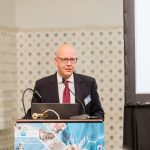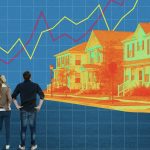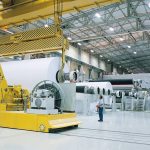Tikvah – A New Jewish Museum for Lisbon
Daniel Libeskind, the renowned architect who designed the Jewish Museum in Berlin and who did the master plan for Ground Zero in New York, has agreed to design the new Jewish museum in Lisbon. It will be called Tikvah, which means hope in Hebrew.
The project of a Jewish museum in Lisbon goes back some twenty years. It was about to materialise in 2016 when the Municipality of Lisbon, the Drahi Foundation and the Jewish Community signed a memorandum of understanding to build a museum. It was going to be in Alfama, the oldest district of Lisbon, which for several centuries housed a ‘Judiaria’, or Jewish quarter, but after local residents who opposed the project got a court order to stop it the Lisbon Council agreed to look elsewhere in Lisbon. They offered three sites to Association Hagadá, a newly formed non-profit private association, and it chose a prime plot in Belem facing the River Tagus.
A significant date
On 31st March 2021 the Lisbon Council signed an agreement with the Association Hagadá to grant them a 75 year renewable lease of the site where the new Jewish Museum will be built. The date chosen was particularly significant because it also marked the 200th anniversary of the formal abolition of the Inquisition in Portugal.
Hagadá is a private not for profit organisation set up for the purpose of designing, building and running the museum and it will also be responsible for finding donors and financial backers for the project. Its president, Esther Mucznik, is the daughter of a former rabbi of the Lisbon Jewish community and is currently the vice-president of the community. She will be responsible for designing and organising the contents of the museum.
“The Museum of Hope is going to be built on a wonderful site,” says Esther, “facing the Tower of Belem, one of Lisbon’s most recognisable landmarks. It is just a short walk along the River Tagus from the Jerónimos Monastery and the nearby museum area.
“We are especially pleased that Roberto Bachmann has agreed to donate to the museum his unique collection of books and materials on the history of the diaspora of Portuguese Jews around the world. It will help to make the Museum an international reference point for study, discussion and research.
“We want the museum to be a place where people can be together, and enjoy the auditorium, the restaurant and the cafe as well as the open area where we plan to display works of contemporary Jewish art. We want it also to be a space for debate and reflection on current issues and for intercultural dialogue. Because, contrary to the narrow vision of those who fear the intermingling of cultures, such dialogue in fact makes a substantial contribution to enriching the identity of a people and a country.
“ And we have in Daniel Libeskind an architect who understands the fundamental nature of light and its importance in Lisbon. He has the ability to design a museum which can make the fragments of the history of the Jews in Portugal into a whole new story.”
A museum to hope
Daniel Libeskind – The architect of light designs a museum of Hope for Lisbon, the city of light
In his book Adventures in Life and Architecture Libeskind describes the fundamental nature of light in his designs. He says that when designing the Master Plan for Ground Zero “I imagined a triangular plaza which would become lower Manhattan’s largest public space. I called it “The Wedge of Light” and it was inspired by the ray of sunshine that had made its way down as we toured the bathtub (the name we gave to the 16 acre 70 foot deep pit created after the debris of the Twin Towers was removed)”.
He later describes the effect light can have and how the temples at Paestum in Southern Italy “rose into the sunlight and stood in seeming defiance of gravity. The beauty was unsurpassable.” Later he realised “temples were venerated not just as architecture, but as gods in stone; lit up, they seemed filled with life, animated by ideas, ideals. Light is divine.”
But the absence of light can also be meaningful. “When I designed the Jewish Museum in Berlin, I was tempted to build a room that had no light. The museum chronicles two thousand years of Jewish history. Could there be one unsparing, pitch-black, hopeless volume in it to represent everything that was lost during the Holocaust?” He remembered a story told by a survivor of being transported in a cattle wagon and finding a vision of hope when she caught sight of the sky through the slats in the roof. Inspired by this vision Libeskind designed the Holocaust Void, which is set apart from the rest of the museum, empty and forbidding. “But it is not dark. High in the ceiling, and angled so acutely that you can’t see it, is a slit that lets in a line of light, which is then reflected on the concrete walls and floor of the Void.”
“Light is the measure of everything. What you remember is in light, the rest is in darkness. The past fades to dark, and the future is unknown, just stars.”
“Light is about letting the darkness be there. … Light becomes tangible only when it lands on something solid – a body or a building – when it crawls, darts, engraves its presence on a wall. A city reveals itself in the shadows that its buildings cast. What colour is light? Whatever colour it alights on.”
The experience of loss
Libeskind is clear that he brings the personal history of his family to bear on his work. “As someone who was born in the post-Holocaust world to parents who were both Holocaust survivors, I have thought a lot about trauma and memory. Not the trauma of a singular catastrophe that can be overcome and healed, but a trauma that involves the destruction of a community and its real yet virtual presence. I find myself drawn to explore what I call the void – the presence of an overwhelming emptiness created when a community is wiped out.”
“Buildings have hearts and souls, just as cities do. We can feel the memory and meaning in a building, sense the spiritual and cultural longing it evokes.” Many of Libeskind’s projects look at the deep cultural connections between memory and architecture. In the case of the Jewish Museum in Lisbon he says “I organised the museum as a story of how hope accompanied and united the Jewish community.”
Daniel Libeskind
Daniel Libeskind was born in 1946 in Lodz in Poland which was then under Communist rule. His parents had fled Poland when Hitler invaded in 1939 and had met in the Gulag where they were both imprisoned by Stalin. After Hitler invaded Russia in 1941 they were released and after the war returned home to Lodz, only to find their family and friends all dead, and Jews not welcome. In 1957 they moved to Israel and then on to New York.
As a child Daniel was a highly talented musician and accordion player. He is married with three children and lives and works in both Berlin and New York.
The significance of hope in Jewish culture and history
Hope has always played a major role in Jewish life, hope for a better world, hope for more learning or a better life here and now, or hope for the arrival of the Messiah when all nations will come together in peace. In his book The Dignity of Difference Jonathan Sacks, then the orthodox Chief Rabbi of the UK, argued that “God’s choice of the Jews was God’s way of teaching humanity to make space for difference, by affirming that different peoples should worship God differently.
“In historical terms Judaism represents a living alternative to empires and to their drive to impose on humanity a single form of truth and power. Under all five of the great universalist cultures of the West – Alexandrian Greece, ancient Rome, mediaeval Christianity, Islam and the Enlightenment – Jews have suffered. But the Jews’ continued survival offers a well-spring of hope for humanity. The promise that the righteous of all nations will be redeemed is a religious underpinning for human belief in our capacity to dream of and work for a better world.”
Libeskind points out that the Jews have no word for tragedy; in Hebrew the word is borrowed from the Greek tragodos. Hope, Sacks declares, is a Jewish characteristic. “Jews have never – despite a history of sometimes awful suffering – given up hope.”
Rabbis in Portugal and their hope for the future
The stories of the role of Jews in the Discoveries and of the forced conversion of the Jews of Portugal following the Edict of Expulsion in 1497 have been almost completely forgotten. King Manuel imposed the Edict because he wanted to marry the daughter of the Spanish monarchs Ferdinand and Isabella and she refused to marry unless all Jews and Muslims in Portugal converted to Christianity or went into exile. It is estimated that following the expulsion of Jews from Spain in 1492 and the arrival of many Spanish Jews in Portugal 10% of the population of Portugal was Jewish.
D Manuel promised ships to take Jews to other countries but in fact no ships were provided and instead the Jews were all taken to nearby churches and forcibly converted. He then promised that at least 30 years would pass before any checks were made on whether the new converts, or New Christians, were living according to the precepts of the Catholic Church or whether they were still practising Jewish rites in secret.
Among the Jews caught in the Portuguese net were three Jews who had come from Spain. Abraham Zacuto had invented the astrolabe which was used by Vasco da Gama on his voyage to India, Rabbi Avraham Sabba had been the head of the Jewish community in Zamora but was now living in Guimaraes and Rabbi Isaac Caro had come to Lisbon to teach Torah (Jewish law).
“My students were like bright light for eyes wishing to see, as stars in the sky,” Rabbi Caro wrote. After the Edict of Expulsion “I ran away from the decrees of the King of Portugal; during our journey all my sons died,” but he was determined to write his thoughts for posterity. “A person’s good deeds and Torah scholarship are like his children. That’s why I am writing this book of Torah.” His book The Progeny of Isaac was published in Constantinople in 1517.
Rabbi Sabba suffered a similar fate. “By royal decree my library was confiscated,” he later wrote, “Risking my life I kept a manuscript with me, my commentary on the Torah, my most precious possession.”
Expecting boats to be available he travelled to Lisbon but “upon our reaching there terrifying news spread. Anyone caught with Jewish texts would be killed. Outside Lisbon I dug a hole. Underneath an olive tree I buried my life’s work. It was a beautiful olive tree, safeguarding my Torah ideas and thoughts. To me it was a tree of tears.”
Rabbi Avraham Sabba refused to convert but after many months in prison he was allowed to sail to Morocco. His family had been forced to remain in Portugal but he showed tremendous resilience. “I decided to rewrite my Torah commentary from memory to be able to share what had been lost and to restore the crown to its former glory. But I don’t know if I recalled all of it correctly, as my initial manuscript was left behind in Portugal”.
Rabbi Avraham Sabba’s commentary in Hebrew was called A Bouquet of Myrrh and was eventually printed in Venice in 1523, 15 years after his death on his way to Italy. The works of Rabbis Caro and Sabba live on and are still cited by other commentators. They are a living tribute to their hope which never died, and to their belief in a better future.
History of the Jews in Portugal
There has been a Jewish presence in Portugal for at least 2,000 years. For 1,000 years before the Portuguese nation was founded Jews lived in the territory now called Portugal under Roman, Visigoth and Muslim rule. Subsequently they lived through periods of peaceful co-existence and intolerance under the Kings of Portugal.
Up till now Lisbon has been one of the few major European cities that does not have a museum to celebrate and remember the Jewish presence in the country. Out of the history of the Jews of Portugal has grown a unique diaspora and culture which has spread across the whole world. The purpose of the new Tikvah museum is to explain this history and to show it to both foreign visitors and to the people of Portugal, many of whom know nothing of the richness of this history.
The history of all peoples is also the the history of their interactions. The life of the Jews in Portugal is a Jewish and Portuguese history. The museum will show the contribution of the Jews to Portugal and demonstrate that Jewish history and culture are an integral part of the history of this country.
Tikvah museum – The permanent exhibition
The permanent exhibition will include
1 Jewish culture and traditions
2 A review of the history of the Jews in Portugal organised by themes covering five key periods
The Jews under Roman, Visigoth and Islamic domain;
The age of the “Convivência” also known as “The Time of the Jews”, from the XII to the XV centuries;
The Age of Intolerance: Expulsion, forced Conversion, Inquisition;
The Portuguese-Jewish Diaspora, between the XVI and XVIII centuries;
The contemporary Revival of Judaism in the XIX-XX centuries
Completion in three years time
The new museum will be divided into 5 blocks, each one in the form of the Hebrew letters which spell the name Tikvah. “We will not hesitate to use all available means to stimulate public interest, particularly among the young,” says Esther Mucznik. “We have no preconceptions. The bottom line is that the story we are telling should be interesting and appealing, without departing from the truth of what happened.”
Hagadá is committed to raising the financing for the new Museum and getting planning permission next year so that it can be built and completed by 2024. This is an ambitious target in a city which is known for its bureaucratic delays but there is no doubt that the opening will be a major event for the city of Lisbon. It will not just lift the city’s international profile, it will be a significant acknowledgement of the contribution that Jews have made over the centuries to Portuguese life and culture.










